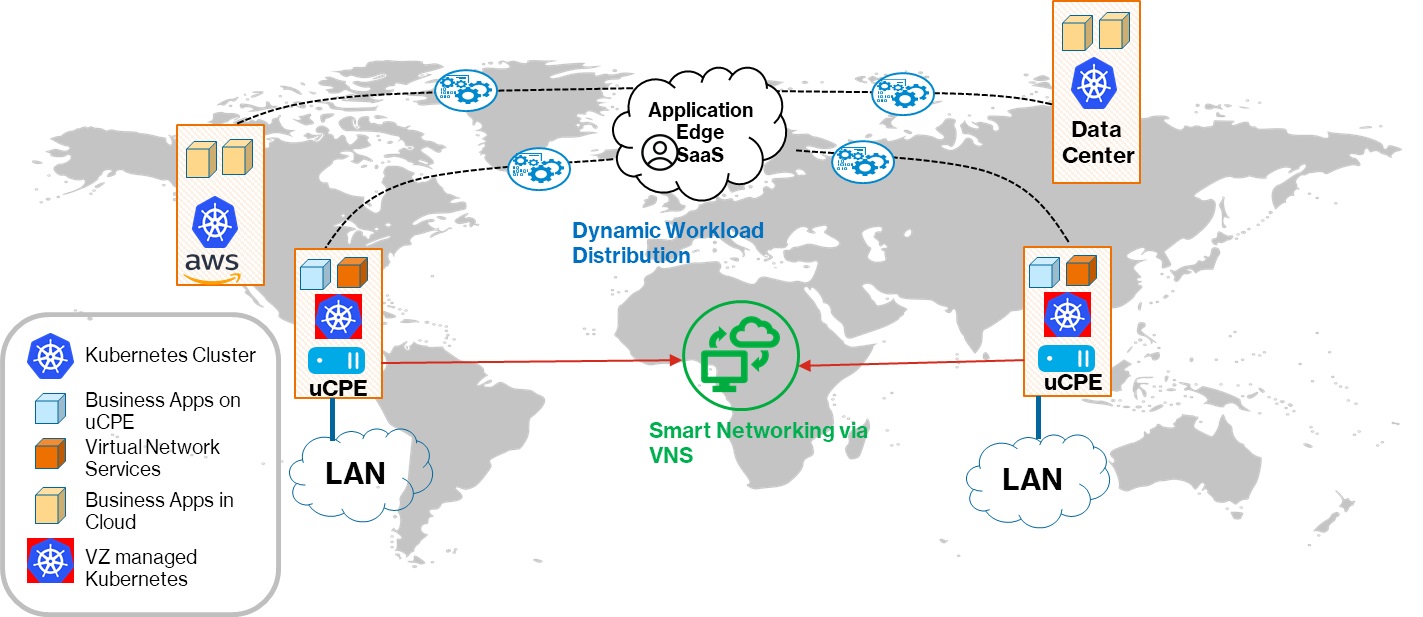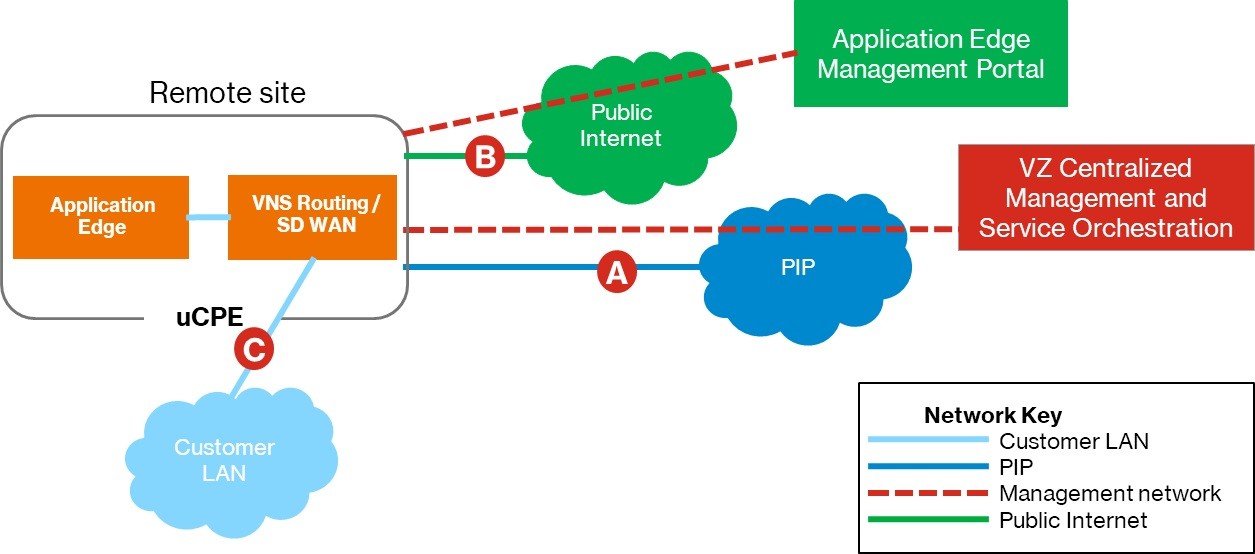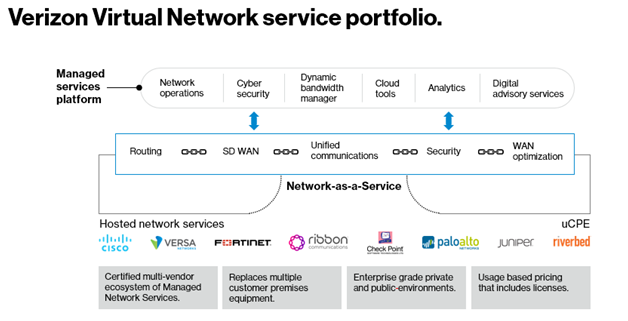VNS Application Edge is an entirely different way of orchestrating, hosting, deploying, and managing customer containerized applications at the network edge and across heterogeneous clouds.
VNS Application Edge, available as a VNS service on the premise-based uCPE, provides a means for application lifecycle management and multi-cluster deployments of containerized applications.
This is possible by giving you the ability to securely and easily host, manage, and control your own applications at your remote locations through the Verizon VNS Application Edge portal while helping to optimize performance by deploying applications where you need them to be in your networks.
That means, latency sensitive or data intensive applications can be deployed on site helping to provide a better user experience and a more efficient use of bandwidth.
An added benefit of the solution is Verizon manages both your network and the application infrastructure at the edge. This premise based complete Kubernetes cluster is securely and logically separated from any other VNS network services on the same uCPE device.
You manage the Kubernetes platform—monitoring and upgrading the platform as required, while Verizon monitors and manages the underlying uCPE hardware and network infrastructure, just as Verizon would do with any other VNS service.

Figure 1: VNS Application Edge in a Nutshell
The power of VNS Application Edge comes from the VNS Application Edge management portal that enables you to deploy and manage all your Kubernetes clusters through the entire Software Development Lifecycle (SDLC).
This means that you can easily manage of your applications across your WAN networks, without having to worry about managing the network itself, while having the ability to centrally manage all of your Kubernetes clusters, wherever they are in your network, at their remote edge locations, or in multiple public or private clouds.
VNS Application Edge is network and VNS Solutions Bundle agnostic enabling you to deploy your applications on whatever LAN or WAN network environment you choose.
Note: You will need to have at least one of these VNS functions deployed: SD WAN, , or Routing in order to implement VNS Application Edge. You must also have or allow Internet connectivity to enable access to the portal.

Figure 2: Application Edge Network Diagram
Key features of this service include:
- App Ready Kubernetes Cluster: The VNS Application Edge clusters are deployed by Verizon during the standard VNS service delivery process, ready to be used as soon as you are given access to the Portal.
Note: Therefore, there is no manual set-up required, helping to eliminate the tedious and time-consuming effort required to deploy clusters at any scale beyond a handful.
VNS Application Edge allows you to manage automated Kubernetes upgrades and software patches across multiple locations through the easy-to-use portal.
- Multi-cluster/Multi-cloud management via a Single Pane of Glass: You are able to manage hundreds or thousands of Kubernetes clusters from one central management portal, for tighter control of the environments wherever they are located on your network edge and/or in multiple public or private clouds.
- Note: You can make uniform changes and updates to applications and the cluster itself can be made across all or selected sites simultaneously regardless of location – at the edge or in the cloud.
- Single pane of glass: The VNS Application Edge Portal, which is accessed by a link on your Verizon Enterprise Center Dynamic Network Management (DNM) portal, allows you to manage not only all of your VNS Application Edge Kubernetes clusters located on your remote sites, but also your Kubernetes clusters from third parties located in public and private clouds.
Note: This enables you to deploy and upgrade your apps from a central place, helping to reduce management overhead and the potential for errors
Note: You also receive monitoring support and proactive notification through the Portal. - Software development Life Cycle: The Portal allows you to manage the full application lifecycle from one central portal.
- Comprehensive Kubernetes Management Platform: The VNS Application Edge portal includes tools to manage the Kubernetes platform itself, which helps to simplify updates and Software Development Life Cycle processes across all the Kubernetes clusters under management.
- Security: You have access to the VNS Application Edge Portal environment through the Verizon Enterprise Center Dynamic Network Manager (DNM) portal, which allows you to use the Verizon Enterprise Center Role Based Access Control (RBAC) features, plus additional more fine-grained access controls on the VNS Application Edge Portal. You can therefore control exactly who has access and what they can do with that access.
Note: Verizon does not have access to either your VNS Application Edge Portal or any applications that are deployed within the VNS Application Edge cluster itself.
- Optimized App performance: Bringing applications that demand low latency, near real-time processing, or both closer to the end-user, help enable new immersive experiences like virtual reality and 4K content delivery networks and can add opportunities for real-time data analysis and decision-making using artificial intelligence and machine learning.
- More efficient use of bandwidth: Depending on the application, there is the potential for more efficient use of the bandwidth at the remote site, since the applications might take advantage of the ability to pre-process the data and only transmit the important information in a more compact form into public or private cloud locations.
That also means that on-premises data sent to a data center or the cloud can be aggregated.
The service is available with a choice of 3 capacity sizes based on a standard amount of compute, storage and memory resources allocated.
These resources are pinned, that is reserved your use only to help assure that the cluster will perform as expected. These resources are logically and securely separated from the other components on the uCPE.
That means the applications have fixed resources available, as contracted for, and do not compete for resources from oversubscription or noisy neighbors from any other services deployed on the same hardware.
The 3 options with details of the resources available for each are listed below:
- Small: A ready built Kubernetes managed container environment that includes 8 cores, 16GB Random Access Memory (RAM) memory, and 400GB persistent storage.
- Medium: A ready built Kubernetes managed container environment that includes 16 cores, 64 RAM memory, and 2 Terabytes (TB) persistent storage.
- Large: A ready built Kubernetes managed container environment that includes 24 cores, 128GB RAM memory, and 3.5TB persistent storage.
Once VNS Application Edge has been deployed at the location by the Verizon Service Delivery team, you will have access to the VNS Application Edge portal from the Verizon Enterprise Center and will be able to deploy and manage your applications. As with any of the VNS services, Verizon manages the underlying environment, the virtual machine image itself and any other support of the service.
The service is sold with the Co Management service level. Application and cluster management is your sole responsibility. Verizon does not manage or deploy your applications or maintain or upgrade the Kubernetes cluster.

Figure 1-9: VNS Application Edge Architecture Overview














